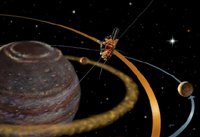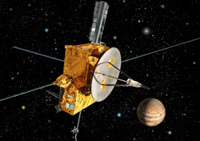Jupiter
Introduction
 |
|
Artist's impression of Ulysses swinging by Jupiter (D. Hardy). |
Ulysses arrived at Jupiter 16 months after departing from Earth, having travelled nearly 1 billion kilometers. Closest approach to the planet occurred at 12:02 UT on 8 February, 1992. The primary aim of the flyby was to place the spacecraft in its final heliocentric out-of-ecliptic orbit with a minimum of risk to the onboard systems and scientific payload. Scientific investigations at Jupiter are a secondary objective of the mission. Nevertheless, the opportunity to study Jupiter's magnetosphere was exploited to the greatest extent possible. The results exceeded all expectations of the scientists involved.
Plasma and Magnetic Field
On 2 February, almost a week before closest approach, Ulysses crossed the Jovian bow shock at a distance of 113 Jupiter radii (1 Rj = 71 398 km) from the planet. The inbound crossing occurred somewhat earlier than expected based on previous observations by the Voyager spacecraft. A possible interpretation is that the solar wind ram pressure was low, allowing the magnetosphere to temporarily inflate, causing the bow shock to stand off further out from the planet. The magnetopause, the outer boundary of the magnetosphere, was first encountered only four hours after the bow shock crossing, at a distance of 110 Rj. The apparent proximity of these two boundaries, which are typically separated by 20 Rj, also suggested that they were moving rapidly outwards at that time.
Other results to emerge from magnetic field observations include the previously unknown configuration of the dusk side field, which is strongly swept back towards the magnetotail, and the realisation that large-scale current systems are very important in determining the configuration and dynamics of the magnetic field.
Radio and Plasma Waves
Jupiter is a prolific source of natural radio waves, emitting at many wavelengths. The unique direction-finding capability and high sensitivity of the Ulysses radio and plasma wave (URAP) experiment provided new insights and clues as to the origin of these radio signals. For example, the narrow-band kilometric (nKOM) radiation was found to originate from discrete, long-lived sources that are located in the outer regions of the Io Plasma Torus, and which rotated around Jupiter at slightly different rates. Ulysses observations of the hectometric radiation (HOM) revealed narrow latitudinal beaming along the magnetic equator. Several bursts of radio emission showing a characteristic rapid drift in frequency, Jovian type III events were detected with Voyager. Ulysses recorded many events of this type, and they appear to be a major component of Jupiter's radio spectrum.
Plasma Composition
The Ulysses solar wind ion composition (SWICS) experiment provided important new data on the composition of the magnetospheric plasma, in particular information on the charge states of the various ions. These measurements provided new insights into the sources and life history of the Jovian plasma. Material from three sources, the solar wind, the planet itself and the volcanic satellite Io (Iogenic ions) can be traced by observing ions specific to each source. Large-scale mixing was observed to occur.
Io Plasma Torus
The Io Plasma Torus (IPT), a doughnut-shaped ring of plasma rotating with the planet at the orbit of Jupiter's moon Io, was an object of special interest during the flyby. The IPT consists largely of ionised oxygen and sulfur atoms released as a neutral cloud by Io's volcanoes. The electron density of the IPT, measured by Ulysses a few hours after closest approach as the spacecraft crossed Jupiter's magnetic equator, were in good agreement with predictions based on older Voyager results.
Energetic Particles
The energetic particle intensities measured by the Ulysses instruments during the flyby were generally lower than observed by the Voyager spacecraft. A major discovery during the outbound pass was the existence at high latitudes of very strong counter-flowing streams of electrons and ions, constituting large currents that apparently feed into the auroral regions.
Polar Cap Region
 |
|
Ulysses approaches Jupiter |
Because of its high-latitude trajectory, Ulysses was able to investigate the poleward extent of Jupiter's radiation belts. A surprising finding was that, even close in to the planet (approximately 9 Jupiter radii), Ulysses apparently made an excursion out of the radiation belts at relatively low magnetic latitudes (48°).
